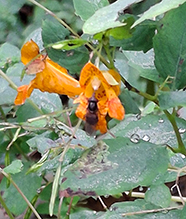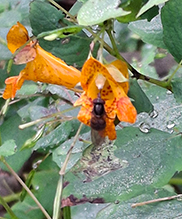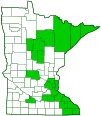American snout fly
(Rhingia nasica)
Conservation • Description • Habitat • Ecology • Distribution • Taxonomy
Conservation Status |
|||
| IUCN Red List | not listed |
||
| NatureServe | NNR - Unranked SNR - Unranked |
||
| Minnesota | not listed |
||
Description
Rhingia is a genus of small to medium-sized hover flies. There are at least 24 Rhingia species worldwide. Rhingia nasica (American snout fly) is the only member of the genus that occurs in North America.
American snout fly is a common, small to medium-sized, hover fly. It occurs in the United States from Maine to northern Georgia, west to Minnesota and Arkansas, and in southern Canada from Nova Scotia to Alberta.
Adults are active from May to September. They are found in deciduous forests, bogs, and fens. They feed on the nectar of a variety of flowers, including aster, brambles, geranium, goldenrod, knapweed, touch-me-not, and violet. The larvae are thought to be associated with the dung of large, plant-eating animals. They have been associated with cow dung.
Adults are ¼″ to ⅜″ (6 to 9 mm) in length.
The head is hemispherical and wider than the thorax. The face has a distinct, long, forward-directed snout. The antennae are short, they have three segments, and they are inserted well above the middle of the face. There is a long bristle (arista) on the upper side of the third segment. The arista is longer than the antennae and it is very slightly hairy, almost hairless. The compound eyes are hairless. On the male they meet at the top of the head for a long distance. On the female they are well separated.
The thorax is black and rectangular, almost square. The large exoskeletal plate (scutum) covering the middle segment of the thorax has three gray longitudinal stripes. The two lateral stripes are complete, extending from the rear margin to the front margin. The middle stripe is partial, extending from the rear margin just halfway to the front. The small plate covering the rear part of the middle segment (scutellum) is yellowish and more or less translucent. There are no bristles on the scutum or scutellum. The small plate in the shoulder area just behind the head (postpronotum) is hairy.
The abdomen is short and wide. It is convex when viewed from above.
The wings are clear, unmarked, and lightly tinted brown. The vein on the leading edge (costa) and the vein R4+5 end well before the wingtip.
Size
Total length: ¼″ to ⅜″ (6 to 9 mm)
Similar Species
Habitat
Deciduous forests, bogs, and fens
Ecology
Season
May to September
Behavior
Life Cycle
Larva Food/Hosts
Large herbivore dung
Adult Food
Flower nectar
Distribution |
||
|
Sources Telford, Horace S.. (1939). The Syrphidae of Minnesota. University of Minnesota. Minnesota Agricultural Experiment Station. |
|
| 9/27/2025 | ||
Occurrence |
||
|
||
Taxonomy
Order
Suborder
Brachycera
Infraorder
Cyclorrhapha
Zoosection
Aschiza
Family
Syrphidae (Hover Flies)
Subfamily
Eristalinae (drone flies and allies)
Tribe
Rhingiini
Subtribe
Rhingiina
Genus
Rhingia (snouted hoverflies)
Subordinate Taxa
Synonyms
Common Names
American snout fly
Glossary
Arista
A large bristle on the upper side of the third segment of the antenna of a fly. Plural: aristae.
Costa
On ferns: The central axis of a pinna, to which pinnules are attached. On mosses: the central axis (midvein) of a leaf. On insects: The vein on the leading edge of the forewing.
Scutellum
The exoskeletal plate covering the rearward (posterior) part of the middle segment of the thorax in some insects. In Coleoptera, Hemiptera, and Homoptera, the dorsal, often triangular plate behind the pronotum and between the bases of the front wings. In Diptera, the exoskeletal plate between the abdomen and the thorax.
Scutum
The forward (anterior) portion of the middle segment of the thorax (mesonotum) in insects and some arachnids.
Visitor Photos
Share your photo of this insect.
This button not working for you?
Simply email us at info@MinnesotaSeasons.com.
Attach one or more photos and, if you like, a caption.
Luciearl |
||
 |
 |
|
MinnesotaSeasons.com Photos
|

Slideshows

Visitor Videos
Share your video of this insect.
This button not working for you?
Simply email us at info@MinnesotaSeasons.com.
Attach a video, a YouTube link, or a cloud storage link.
Other Videos



